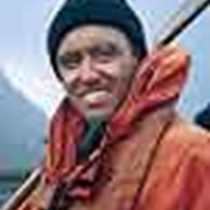After a glorious day below the Antarctic Circle yesterday, this morning we headed back north through the Lemaire Channel, amidst billowing low thick fog with skyscraping mountain-tops looming above the mist. At the north end of the channel we burst out of the fog into a shockingly sun-drenched landscape. The mountains of the Danco Coast of the peninsula off to starboard vied with the stunning heights of Mt. Williams and Mt. Français on Anvers Island to port, and the ‘seven sisters’ of Weincke Island just ahead. By lunchtime we had arrived in Port Lockroy, a sheltered harbor between Anvers and Weincke islands.
Port Lockroy is one of the most well known historical sites in the region. First discovered on February 19th, 1904 by the French explorer Jean Baptiste Charcot, Port Lockroy was named by him for a prominent politician who had helped fund Charcot’s first expedition of 1903-05. Goudier Island, the speck of land in the center of the bay, Charcot named for his dear friend and chief engineer of his expedition ship, Français. By 1911, Norwegian whalers were frequenting this sheltered anchorage because already whale catches further north in the South Shetlands had begun to decline. Port Lockroy was to be used heavily by whaling ships through the 1930’s, and evidence of their presence is still obvious in the form of mooring pins drilled in the rocks, heavy chains draped around granite headlands, deteriorating water-boats ashore, and piles of bones – all that is left of the leviathans these men hunted with such skill and persistence.
By World War II whalers had largely abandoned local waters, as their prey had been exhausted. There was concern in London that the enemy might use such sheltered harbors and supplies abandoned by the whalers to somehow harass shipping in the South Atlantic, and so the Royal Navy launched Operation Tabarin, to establish bases in the Antarctic to solidify British control over the region. Bransfield House was built in 1944 here on Goudier Island, partly from wood salvaged from the abandoned whaling station at Deception Island. The station was operated continuously for nearly 20 years, then abandoned until the mid-1990’s. Now it is staffed in the summer as a Heritage Site, Visitor’s Center and Museum. We were able to not only go ashore in this spectacular setting to get a sense of life on a station surrounded by nesting Gentoo penguins, but also once again launch our kayaks for an intimate look at Antarctica in a heart-stopping setting. What a brilliant day!




